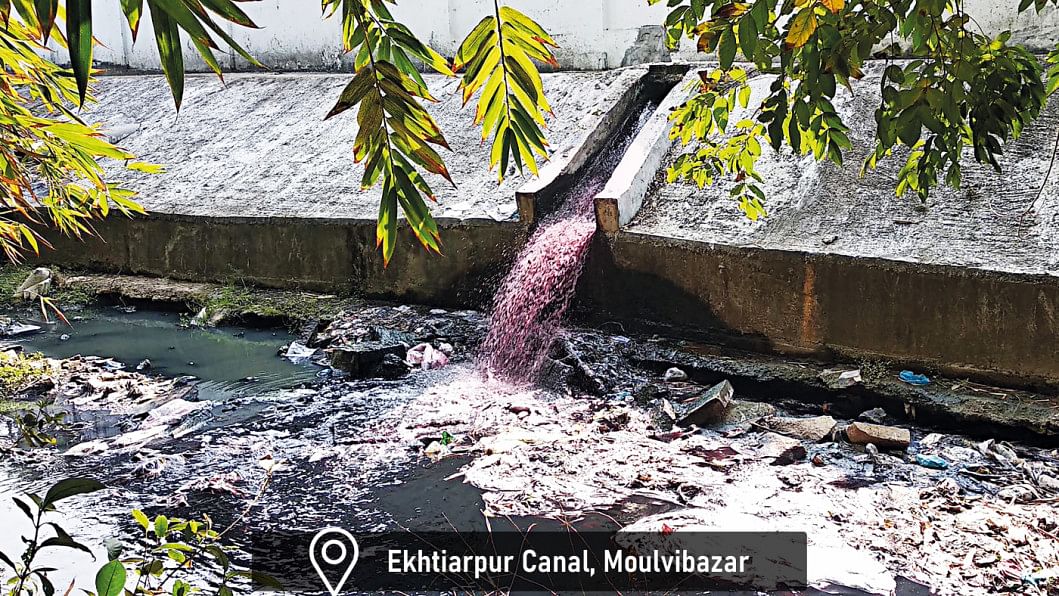Waterbodies at the mercy of polluters

The effluent from several industries in Madhabpur upazila of Habiganj is polluting local canals and rivers, threatening fish population and adversely affecting people’s lives in the area.
Although the authorities concerned claimed that they continuously monitor the 26 factories operating in Madhabpur, locals and experts said dumping of toxic water and waste in the waterbodies is rampant in the upazila.
During a visit in December, this reporter saw waste water oozing out from different pipes and drains into Madhabpur’s Ekhtiarpur canal, turning the otherwise clean waterbody blackish red and malodourous.
“I have been fishing in the canal since my childhood. But for the last three years, fish is disappearing fast from the canal due to pollution,” said 65-year-old Inu Mia, a resident of Shahpur village of the upazila.
“The stench is so severe that it is impossible for us to concentrate on work,” he told The Daily Star.
Ambar Ali, another resident of the same village, said pedestrians have to wear mask or use a piece of cloth to cover their face whenever they pass by this area.
“Our croplands are also losing fertility because we use polluted water from the canal for irrigation,” claimed Khairul Islam Manu, former chairman of Chhatian Union Parishad under Madhabpur.
He said, besides the Ekhtiarpur canal, the Kasti river and the Bangaduba canal of the upazila have also been polluted.
The Madhabpur Upazila Fisheries Office, however, could not provide any data on fish population of the four local rivers and the seven to eight canals of the region.
Md Abu Asad Faridul Haque, acting fisheries officer of Madhabpur, explained that they collect fish production data from local ponds during rainy season so the impact of pollution in canals and rivers are not reflected in their data.
He, however, admitted that fish can no longer be found in the natural waterbodies because of the polluted water.
“If this polluted water ends up in any pond, it will also harm the pond water,” he added.
Abdul Kayum, a resident of Ekhtiarpur village by the Ekhtiarpur khal, informed that dyeing, spinning, cotton processing plants as well as denim, ceramic, poultry feed and paint producing factories are operating in the area.
An active campaigner against pollution, Kayum claimed that about 30 to 40 factories are filling up lowlands in the upazila for construction.
He alleged that Saiham Knit Composite is discharging untreated effluent into Kharki River, which flows into the Titas River, finally joining the mighty Meghna.
Madhabpur Upazila Chairman SFAM Shahjahan is the knit factory’s director, he added.
Kayum also brought allegations against MAAR Limited, a feed factory in Shahpur, of discharging toxic water into the Jiddarchhara canal that flows into the Beleshwari River.
Although the factory was closed down by district administration on November 30, 2015, locals claimed it is still running operation secretly.
Sharif Jamil, general secretary of Bangladesh Paribesh Andolon (Bapa) central committee, echoed the allegations brought against MAAR Limited and Saiham Knit Composite Limited.
The eminent environmentalist, also a resident of Madhabpur, suspects that the two factories were not set up following proper Strategic Environmental Assessment (SEA).
Talking to The Daily Star, Dr Jahirul Hoque Shakil, an environment science researcher, asserted that some industries have set up effluent treatment plants (ETPs) just for show.
They do not operate the ETPs to save money because ETPs need electricity and other expenditure to operate, said the professor of Shahjalal University of Science and Technology.
Contacted, SFAM Shahjahan, denied all allegations of pollutions against the company.
He held that they operate ETP in full-fledge so that no wastes or toxins are dumped on waterbodies.
This correspondent tried to contact MAAR Limited. But the three phone numbers, which were available at the company’s website, were found switched off.
Meanwhile, Tofazzel Sohel, waterkeeper of the Khowai river, told The Daily Star that during their December 3 visit of Ekhtiarpur canal near MAAR’s feed factory in Shahpur, they saw chemical waste of the factory seeping into the land and flowing in the canal.
They found a similar situation visiting Jiddarchhara and Bengaduba khals near Saiham’s factories in Saihamnagar.
Contacted, Aysha Akhter, acting UNO of Madhabpur, said she did not get any complaint against Saiham Group of polluting the waterbodies.
The UNO refuted the allegation against MAAR agro factory still operating defying government ban.
She claimed that her office found the factory closed during a visit in November.
She added that there 26 factories were manufacturing ceramic, feed, veneered board and textile in Madhabpur.
Israt Jahan Panna, director of Department of Environment (DoE) of Sylhet Divisional Office, said, they regularly monitor the industrial units and compel them to operate their ETPs.
Asked if they test the water of the four local rivers and the canals of Madhabpur, the DoE director said they collected water sample from near Saiham Knit Composite on November 11, but declined to share their findings.
Habiganj district’s Water Development Board’s executive engineer MN Shaikat said they are strictly monitoring so that no industries can pollute water.
If anybody pollute water, legal action would be taken against them, he said.

 For all latest news, follow The Daily Star's Google News channel.
For all latest news, follow The Daily Star's Google News channel. 



Comments